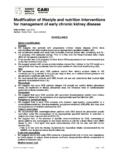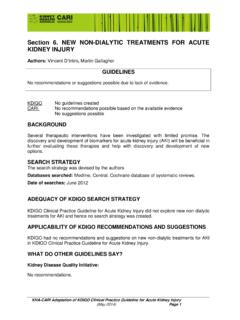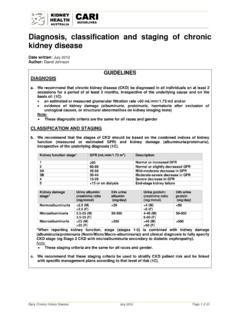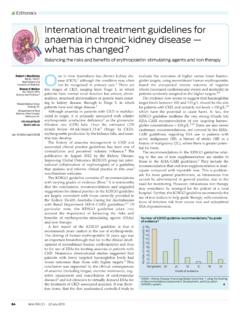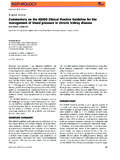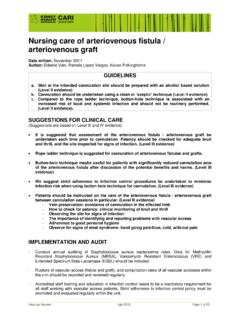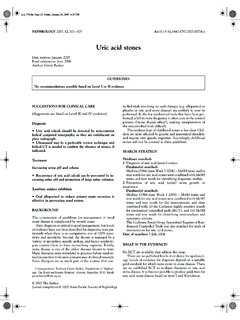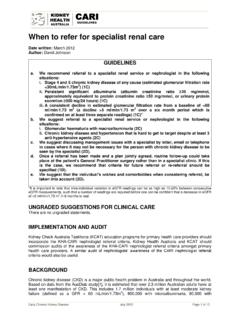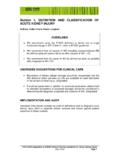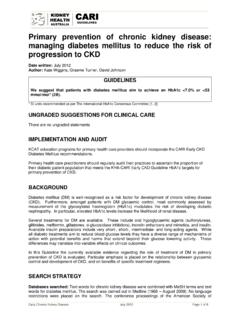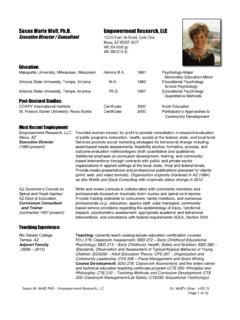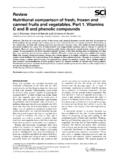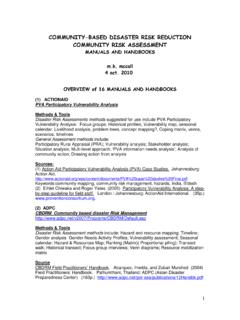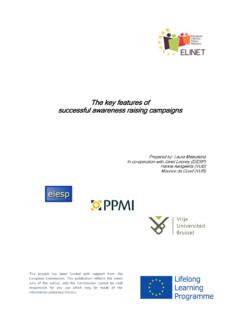Transcription of KHA-CARI guideline recommendations for the diagnosis …
1 Nephrology 21 (2016) 705 716. Original Article KHA-CARI guideline recommendations for the diagnosis and management of autosomal dominant polycystic kidney disease GOPALA K RANGAN,1,2 STEPHEN I ALEXANDER,3,4 KATRINA L CAMPBELL,5,6 MARK AJ DEXTER,7 VINCENT W LEE,1,2. PAMELA LOPEZ-VARGAS,3,8 JUN MAI,9 ANDREW MALLETT,10,11,12 CHIRAG PATEL,13 MANISH PATEL,14,15. MICHEL C TCHAN,16,17 ALLISON TONG,3,8 DAVID J TUNNICLIFFE,3,8 PHILIP VLADICA18 and JUDY SAVIGE19,20. 1. Centre for Transplant and Renal Research, Westmead Millennium Institute, The University of Sydney, Sydney, 2 Department of Renal Medicine, Westmead Hospital, Western Sydney Local Health District, 3 Centre for Kidney Research, The Children's Hospital at Westmead, 4 Department of Nephrology, The Children's Hospital at Westmead, 7 Department of Neurological Surgery, Westmead Private Hospital, 8 Sydney School of Public Health, The University of Sydney, 9 Department of Nephrology, Liverpool Hospital and Bankstown Hospital, 14 Discipline of Surgery, Western Clinical School, The University of Sydney, 15 Department of Urology, Westmead Hospital, 16.
2 Department of Genetic Medicine, Westmead Hospital, 17 Sydney Medical School, The University of Sydney, 18 Department of Radiology, Westmead Hospital, Western Sydney Local Health District, New South Wales, 5 Department of Nutrition and Dietetics, The Princess Alexandra Hospital, 6 Faculty of Health Sciences and Medicine, Bond University, 10 Kidney Health Service and Conjoint Kidney Research Laboratory, Royal Brisbane and Women's Hospital, 11 Centre for Kidney Disease Research, Centre for Chronic Disease and CKD, QLD, School of Medicine, The University of Queensland, 12 Centre for Rare Diseases Research, Institute for Molecular Bioscience, The University of Queensland, 13 Genetic Health Queensland, Royal Brisbane and Women's Hospital, Brisbane, Queensland, 19 Department of Nephrology, The Royal Melbourne Hospital, Parkville, and 20 Department of Medicine, The University of Melbourne, Victoria, Australia KEY WORDS: autosomal-dominant polycystic kidney disease, clinical practice guidelines , genetic renal disease, management.
3 Correspondence: Dr Gopala Rangan, Centre for Transplant and Renal Research, Westmead Millennium Institute for Medical Research, 176 Hawkesbury Road (PO. Box 412), Westmead, NSW 2145, Australia. Email: Accepted for publication 20 October 2015. Accepted manuscript online 29 October 2015. doi: SUMMARY AT A GLANCE. An important further guideline from the CARI. group in Australia - this time relating to adult polycystic kidney disease. SCOPE OF THE guideline PART I: diagnosis , GENETIC COUNSELLING. AND SCREENING. This guideline addresses issues relevant to the diagnosis , management and extra-renal complications of autosomal- Autosomal-dominant polycystic kidney disease is the most dominant polycystic kidney disease (ADPKD). Also included common inherited cause of kidney failure in adults, with a in this summary is a screening algorithm for ADPKD in at-risk prevalence rate ranging between 1:500 and 1 6 Its well- individuals (Fig.)
4 1) and an algorithm for screening intracranial known characteristic phenotype is the development of numer- aneurysms (ICA) (Fig. 2). ous bilateral renal cysts that grow at an exponential rate through 2015 Asian Paci c Society of Nephrology 705. G K Rangan et al. Fig. 1 Screening for autosomal dominant polycystic kidney disease (ADPKD) in at-risk individuals based on the Pei-Ravine Uni ed Ultrasound Criteria for the diagnosis of ADPKD (References 19 and 20). MRI, magnetic resonance imaging; PKD, polycystic kidney disease. Fig. 2 Screening for intracranial aneurysms in newly diagnosed patients with autosomal-dominant polycystic kidney disease (ADPKD). ICA, intracranial aneurysm; SAH, subarachnoid haemorrhage; ICH, intracerebral haemorrhage; MRI, magnetic resonance imaging. 706 2015 Asian Paci c Society of Nephrology KHA-CARI ADPKD guidelines adult life and compress normal renal tissue, resulting in at least a diagnosis : IMAGING.
5 50% risk of end-stage kidney disease (ESKD). In developed guideline recommendations countries, ADPKD constitutes ~5 10% of dialysis popula- 11 Heterozygous germ-line mutations, predominantly in (a) We recommend ultrasound to be used as the rst-line the PKD1 gene (85% of cases)12 or to a lesser extent in the imaging modality for diagnosis (1B). PKD2 gene (15% of cases),13 cause ADPKD and are identi ed (b) We suggest using the age and genotype-dependent in up to 90% of patients. In 10% of patients who meet clinical criterion listed in the succeeding texts for diagnosis in at- diagnostic criteria for ADPKD, mutations in PKD1 or PKD2 are risk individuals (2B) (Tables 1 and 2). not detected with current testing methodologies. (c) We recommend when ultrasound ndings are equivocal Autosomal-dominant polycystic kidney disease is relatively and absolute disease exclusion is required, such as in the asymptomatic during the rst three decades of life, and even renal case of potential kidney donors, that molecular genotyping function can misleadingly remain preserved despite signi cant be performed as the diagnostic gold standard (1A).
6 Cystic renal abnormalities, in part due to compensatory glomeru- lar hyper However, once renal function declines, Ungraded suggestions for clinical care irreversible damage has already been established. Therefore, early identi cation of affected patients is important to allow anticipa- Approach to individuals with equivocal ultrasound diagnosis . Mag- tory treatment such as stringent blood pressure control to reduce netic resonance imaging (MRI) can be considered as an alterna- renal and cardiovascular morbidity, exclusion of disease in at-risk tive for disease exclusion in cases with an equivocal ultrasound individuals and enrolment into potential clinical trials of diagnosis , or when molecular genotyping cannot be carried disease-modifying treatments and changes in treatment. out.
7 Gadolinium enhancement is preferable but not essential Autosomal-dominant polycystic kidney disease is highly pen- and should be avoided in those with glomerular ltration etrant, and all individuals with an ADPKD gene mutation will rate (GFR) <60 mL/min per m2 because of risk of develop ultrasound-detectable multiple simple renal cysts nephrogenic systemic Greater than 10 cysts in total (Bosniak class 1) during their lifetime. The onset is however pro- can be used as a cut-off for making a diagnosis using MRI, gressive, insidious, age-dependent and potentially in uenced by and a total of less than ve cysts for disease exclusion. This is environmental factors. Cyst detection by imaging is dif cult dur- applicable for all individuals older than 15 years (Table 3).22. ing childhood because of their microscopic size at that Whilst molecular genotyping remains the gold standard for Approach to individuals with renal cysts without family history of con rming diagnosis , this test is costly, time-consuming and autosomal-dominant polycystic kidney disease.
8 Due to lack of not always readily ,17 Thus, renal ultrasound has evidence for diagnostic criteria for an individual with ndings been used to diagnose and screen for ADPKD amongst at-risk of cystic renal disease and with no family history, a number of individuals for more than 40 Age-related criteria using factors should be considered when making a diagnosis : cyst number to screen for ADPKD were developed, initially by Ultrasound imaging should be performed on the affected Ravine in 199419 and subsequently revised by Pei in 2009,20 to individual's parents to assess for asymptomatic PKD2. assist in reducing the false-positive and false-negative rate during Ultrasound imaging for extra-renal cystic diseases including the screening of at-risk individuals. liver and pancreatic cysts can aid with diagnosis .
9 The objective of this guideline is to review the evidence for For less typical cases (borderline number of cysts and absence imaging methodology, genetic testing and genetic counselling of frank kidney enlargement), serial imaging studies to track in ADPKD. cyst growth or genetic testing may be necessary to make a diagnosis of ADPKD. If an arbitrary number for renal cyst count is to be enforced, Table 1 Diagnostic criteria for at-risk individual with positive family history then 10 cysts in total detectable on ultrasound is the general Age (years) Number of cysts consensus. 15 39 At least three (unilateral or bilateral). 40 59 At least two in each kidney >60 At least four in each kidney . Source: Pei et al. (2009).20 Table 3 Suggested magnetic resonance imaging criterion for at-risk individual older than 15 years with positive family history Autosomal-dominant polycystic kidney disease Number of renal cysts Table 2 Exclusion criteria for at-risk individual with positive family history.
10 diagnosis >10 cysts in total Age (years) Number of cysts Exclusion <5 cysts in total <40 No recommendation For those with equivocal ultrasound ndings not tting into the guidelines previ- 40 Less than two cysts in each kidney ously, and who do not require immediate disease exclusion or con rmation, ex- . Source: Pei et al. (2009).20 pert opinion suggests follow-up imaging with ultrasound in 5 10 years. 2015 Asian Paci c Society of Nephrology 707. G K Rangan et al. diagnosis : GENETIC TESTING ADPKD from their general practitioner in consultation with a clinical geneticist or nephrologist (2A). guideline recommendations (2) We recommend that screening of individuals who are at (1) We recommend that the standard methodology for genetic risk (50% chance) be performed by renal ultrasound and diagnosis of ADPKD is polymerase chain reaction (PCR) that the Pei Ravine uni ed diagnostic criteria for age- ampli cation (including long-range PCR for the rst 33 dependent cyst number (Tables 1 and 2) is used to make exons of PKD1) followed by Sanger sequencing (1A) or and exclude the diagnosis of ADPKD (1B).
